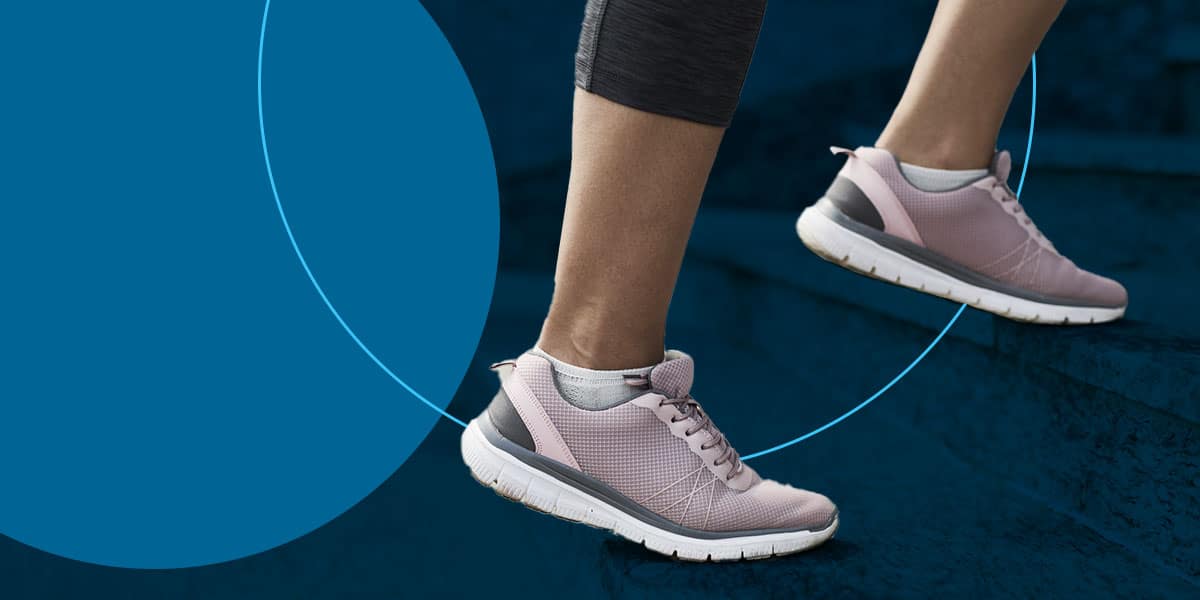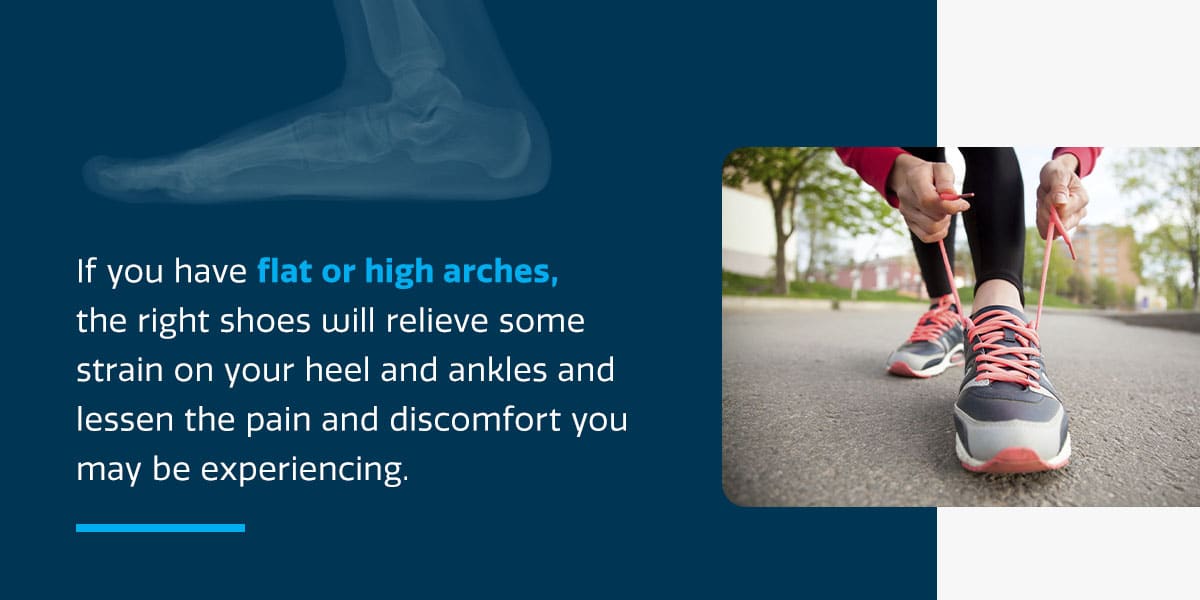
Suppose you’re about to replace your athletic shoes, whether due to discomfort or general wear and tear — knowing which shoes are best for your feet is essential. For this to be possible, you must understand the structure of your foot and the type of arch you have.
Why the Arch of Your Foot Matters
The foot has three arches — two longitudinal arches and an anterior transverse arch. These consist of metatarsal and tarsal bones, supporting ligaments and tendons. The shape of these bones, ligaments and tendons act like a spring to support weight, absorb shock and provide flexibility.
The arch plays a crucial role in foot health by:
- Absorbing shock: When walking, running or jumping, the arch absorbs shock. As a result, the arch lessens the impact strain on other parts of your foot and legs.
- Keeping you balanced: While all parts of the foot assist with balance, the arch has the most significant impact on balance because it allows the rest of the foot to adjust. The arch ensures you stay balanced when walking, standing or running on uneven surfaces.
- Distributing your body weight: The arch also distributes the weight of the rest of your body evenly across the foot. Without an arch, the uneven spread of body weight would build up on the heel and ball of the foot, creating a painful strain.
Because the arch plays a significant role in foot health, it’s crucial to invest in shoes that provide proper support, even more so if you have high or low arches or flat feet.
Types of Foot Arches
Before you start shopping around for shoes, it’s essential to know what type of arch you have. There are three primary types:
Normal Arches
The depth of the medial longitudinal arch is what defines your arch type. You have a normal or neutral arch if your foot is about half-fill and the arch is raised slightly. Your foot is balanced, and you shouldn’t experience pain in muscles or joints.
To confirm that you have normal arches, slip a piece of paper beneath your foot while standing. If the paper effortlessly slips under your foot by the arch, you have a healthy foot posture.
Low Arches or Flat Feet
Low arches and flat feet occur when the foot is underdeveloped. In some cases, children with flat feet later develop healthy arches. But this isn’t always the case. If the arch remains underdeveloped, extra strain impacts the knees, ankles and sometimes the hips and spine. Some of the most common complaints in patients with flat feet are ankle heel pain, shin splints, bunions, calluses and hammertoes.
Often, flat feet tend to point outward when standing as the foot’s natural way of overcompensating for the lacking arch. The easiest way to detect flat feet is with the same paper-slip test. You can also make a footprint to check if an arch is visible at all. If you have flat feet, the entire foot is imprinted.
High Arches
While those with flat feet have arches so low they almost touch the ground, others have high arches. On this spectrum of arch height, less than half of the foot is full, and the arch claims most of the space. Patients with high arches often share common problems like claw toes, joint pain, tight lower calf muscles and calluses.
With this, a foot imprint might only show the toes and heel of the foot, depending on the severity of the arch height. When performing the paper-slip test, the paper can easily slip almost all the way under the foot.
Finding Shoes With the Right Arch Support
Whether you have normal, flat or high arches, it’s vital to wear shoes that provide the right amount of support. The right shoes offer support to assist with balance and posture. If you have flat or high arches, the right shoes will relieve some strain on your heel and ankles and lessen the pain and discomfort you may be experiencing.

The Best Shoes for Normal Feet
If you have normal foot posture, it’s still essential to choose shoes that offer arch and ankle support, especially when exercising. Even though your foot posture is ideal, the right shoes will help you maintain this posture.
The Best Shoes for Flat Feet
If you have flat feet, look for shoes that provide ample cushioning in the midsole. The extra cushion will help absorb some of the shock that your arch cannot. If you are unable to find comfortable shoes with extra cushioning in this area, look for gel or foam inserts that offer similar results.
Flat feet are typically wider, and the feet point outward, so wider shoes with ample toe room will be more comfortable than narrow shoes. Avoid shoes that offer too much toe space, as this will take away from the support the shoes are supposed to provide.
When it comes to the ideal heel drop for those with flat feet, the best approach is to test shoes for comfort. While some patients with flat feet find some heel drop comfortable, some prefer a zero-drop heel that can encourage natural posture.
The Best Shoes for High Arches
If you have higher arches, less of your foot touches the ground, and you need more support from your shoes than those with normal or flat arches. The best shoes for your feet are roomy, provide ample ankle support and offer a flexible midsole with extra cushion.
Look for shoes that are narrow, though not so narrow that your toes feel cramped. You should be able to wiggle your toes comfortably in the right shoes. Wider shoes won’t provide the extra arch support you need.
High arches tend to cause feet to turn inward. The right heel drop can help counter this problem. A low to medium heel drop is typically the best option.
Consult Foot & Ankle Surgical Associates for Expert Insights
Remember that comfort is vital when finding the right shoes for your specific arch needs, specifically when choosing a heel-drop height. It might be more convenient to shop for your shoes online, although it’s always best to test a pair of shoes first. Trying shoes on and walking a few steps in them is the easiest way to evaluate comfort and support.
If you experience any pain or discomfort due to high or low arches, there are treatments that can help improve posture and reduce your symptoms. In some cases, shoe modifications or ankle braces can provide relief — in others, heel-raising procedures and physical therapy are especially beneficial.
Our team of experienced podiatrists can help. Learn more about common foot health concerns, and consult Foot & Ankle Surgical Associates to evaluate the health of your feet and find the right treatment to restore your quality of life.





